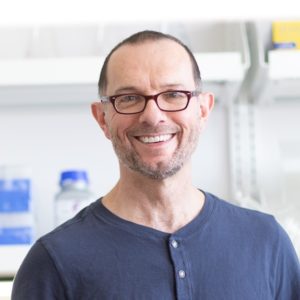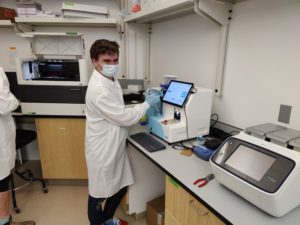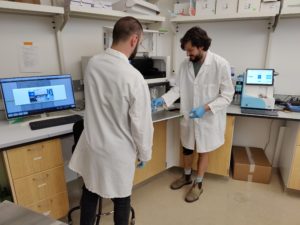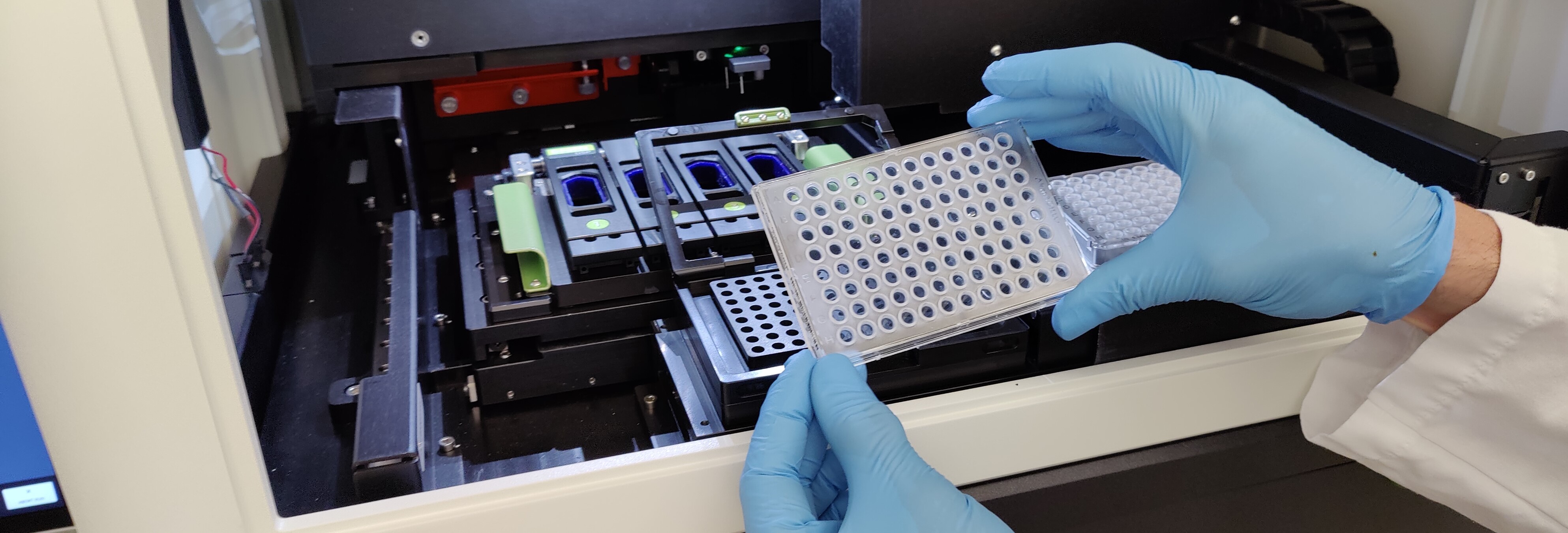by Buck Institute
February 17, 2022 . BLOG
We’re excited about single-cell sequencing technology and think you should be too!

Dr. Simon Melov
Professor Simon Melov is well known at the Buck for his love of cutting-edge technology and his efforts to get the latest and greatest technology in place at the Institute. Melov, whose
lab is focused on identifying hallmarks of aging in order to guide the development of therapeutics, is championing the use of single cell sequencing. He calls it biology’s biggest technological revolution in the last 30 years.
Buck’s Senior Director of Communications Kris Rebillot talked to Melov recently about single-cell sequencing technology:
First the basics – what does single-cell sequencing enable?
Single cell sequencing provides a significantly higher resolution when we look for differences between individual cells within a mixed population. The technology gives us a better understanding of single cells within their microenvironment that comprises tissues and organs.
Why is it so important, especially in research on aging?
 Single-cell technology has tremendous implications across the board, particularly with regards to aging. Why is aging so impacted by this technology? Because aging doesn’t happen uniformly in our bodies all at once. Aging starts one cell at a time -- things go a little bit off-kilter, with a cell inappropriately responding to some stimulus. And then, over time, that leads to deleterious effects in the surrounding tissue, which also ages out of synch. Someone’s kidneys may be aging much faster than their lungs. Aging is not one-size-fits-all.
Single-cell technology has tremendous implications across the board, particularly with regards to aging. Why is aging so impacted by this technology? Because aging doesn’t happen uniformly in our bodies all at once. Aging starts one cell at a time -- things go a little bit off-kilter, with a cell inappropriately responding to some stimulus. And then, over time, that leads to deleterious effects in the surrounding tissue, which also ages out of synch. Someone’s kidneys may be aging much faster than their lungs. Aging is not one-size-fits-all.
Single-cell technology allows us to look at each individual cell and measure the outputs in those cells one at a time, and begin to type them and cluster them in ways where we can functionally characterize particular subsets of individual cells within the tissue with regards to dysfunction or dysregulation. We can look at one percent of cells in a tissue and say, ‘Okay, that one percent of cells is misbehaving very badly and it’s having an impact on the surrounding tissue.’ We would not have seen that if we just took the tissue and averaged across all the millions of cells.
This technology is going to uncover new pathways and paradigms in aging in ways which we have just not been able to do before. It’s going to speed the discovery of drug targets and allow us to track the efficacy of interventions at the cellular level. Many of us who have been in this field for a long time have been waiting for a technological breakthrough which could cast light on the fate of individual cells because we know this asynchronous aspect of aging biology: tissues don’t age synchronously, they age asynchronously. And how do you understand what’s happening in this part of the tissue, versus that part of the tissue? We need to start at the cellular level.
Just so I understand, the traditional way of trying to get to the bottom of what’s happening in tissue, is that you take a sample and mulch it all up -- you make it like a soup, and then you try to understand what’s in that soup. What’s the problem with that method?
Well, if aging is occurring asynchronously and you take some tissue and you mulch it all up, you’re going to average all of the individual cells with each other so that you just get a single signal. Now, in some cases that that may be informative, but in many cases it’s going to obscure the true impact of what’s going on during aging.
Using the soup analogy -- the soup might be composed of 25 different vegetables, right? And the vegetables are composed in different ratios. So you might have, you know, 10% this, 15% that, 25% this, 30% that. And then you’re going to get a taste, which is the amalgam of all of those vegetables, and you’re going to go, ‘Okay, this soup tastes a bit different than this soup, but why does it taste different? I can’t tell why it tastes different?’ I can tell it’s different, but I can’t trace why it’s different.
And what single-cell enables you to do is to take the ingredients and count all the individual vegetables which go into the soup, and then you can say, ‘Okay, this soup is composed of 25% celery, 15% this, you know, 10% this, 10% that.’ And it might be that there’s some spice in there which is heavily altering the flavor of the soup, which is only 1%. And you can taste that spice, but where does it come from? What is that spice? Why is it having an effect on the whole soup? And this is something which we can measure now, and we can do it extraordinarily well with huge sensitivity at two levels. We can do it at the protein level and we can do it at the gene expression level. And this is something which I think people, even scientists still don’t quite understand that this technology works with both proteins and genes. And that is extraordinarily powerful for gaining insight into what’s changing in tissues as we get older.
How is this technology driving research at the Buck?
Late last year the Buck received more than $27 million in federal grants to further research into the stress response called cellular senescence. Cellular senescence leads to chronic low level inflammation and helps drive nearly every age-related disease. We’re looking at it in terms of Alzheimer’s disease and in human ovaries, breast tissue and skeletal muscle. While we are employing different technologies in these projects, I think single-cell sequencing will be the lynchpin because senescent cells arise in only a small fraction of cells within a tissue as we age, and they do not occur in all cells within an organ or tissue type. But because these cells are misbehaving through production of inflammatory factors, they’re having an impact on the surrounding tissue in a way which we can measure with this technology. Measuring that impact is particularly important, not to mention the fact that we can actually identify, characterize, and quantify such cells within the tissue itself. In addition, we recently identified a potential new class of senolytics that can remove or mitigate the effects of cellular senescence. That discovery would not have happened without the use of single cell sequencing.
You’re leading the Rejuvenome Project that the Buck is doing in partnership with the Astera Institute. How will single-cell sequencing impact that effort?
 The technology is front and center of this project – it was actually the reason the project was created. We’re going to use the technology to characterize aging in multiple strains and species of mice and then we’ll use it to track the impact and efficacy of both single and combinations of aging interventions in both cells and in tissues. We will also be testing function in the animals using a custom made Core facility especially for Astera, which is very exciting. We’ll be able to understand the context of changes from single cells to tissue and then to function. That’s never been done before at this scale.
The technology is front and center of this project – it was actually the reason the project was created. We’re going to use the technology to characterize aging in multiple strains and species of mice and then we’ll use it to track the impact and efficacy of both single and combinations of aging interventions in both cells and in tissues. We will also be testing function in the animals using a custom made Core facility especially for Astera, which is very exciting. We’ll be able to understand the context of changes from single cells to tissue and then to function. That’s never been done before at this scale.
This is important because the field is at a crossroads with regards to implementing “big tech” in the context of aging. Smaller projects are being conducted independently of each other, and while there are very promising discoveries, there is little to no research looking systematically at multiple organs or tissues in the context of interventions targeting aging. Aging is complex and interventions which target different functional declines associated with aging are likely to be needed if we hope to impede aging in humans. The Rejuvenome Project is designed to coalesce the most promising research and move it forward. We are actively seeking suggestions from those in the field in regards to interventions that we will be testing.
Finally, how does single-cell sequencing factor into the approach you and your lab take when approaching research on aging?
A key philosophy of the lab is that it is not enough to enhance healthspan through simple dietary or lifestyle interventions. Our argument is that these approaches merely fine-tune us to survive in our current environment. And while lifestyle interventions are great for generally improving health, we need to go deeper in order to uncover the key drivers that limit healthspan and lifespan.
We’ve known for a long time that there are byproducts associated with aging. Why does muscle mass decline with age? Why does inflammation go up with age? Why do proteins misfold with aging? We’ve known these things for years and years and years and yet they are not well understood at any level. We think the use of single-cell technology will enable us to develop therapeutics that are effective in reducing or clearing the cellular damage that arises from the aging process. We believe that this approach will pay massive dividends to improve the health and longevity of a rapidly aging world.

SHARE